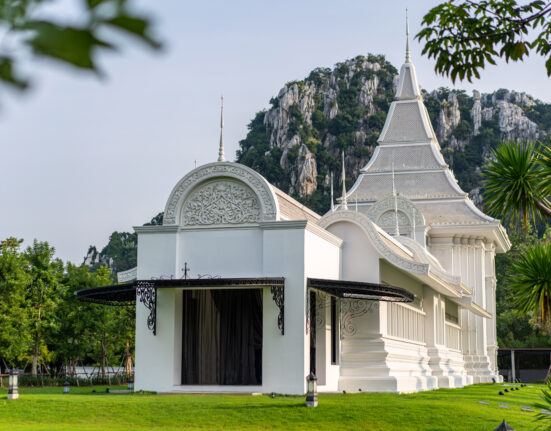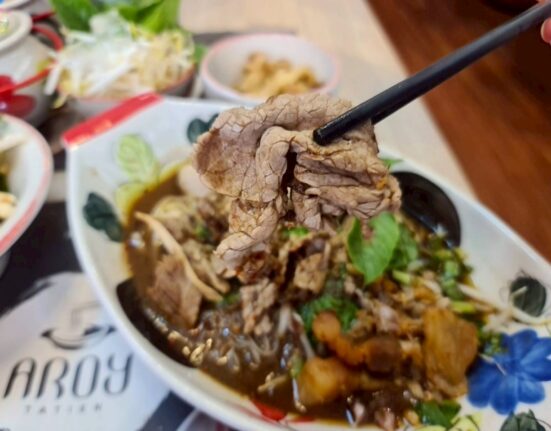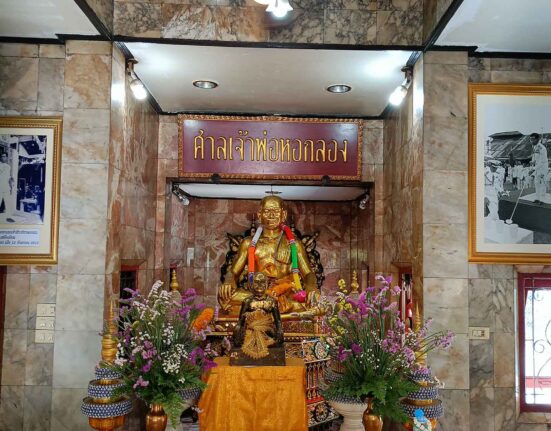By Nai Mu | Featured on Ticy City
Introduction: A Deeper Look into Thai Spirituality
In this mystical chapter of the Yama saga—originally introduced by spiritual storyteller Nai Mu on the Ticy City platform—we embark on a soul-stirring journey through Thai mythology. Follow the divine trail of Thao Phaya Yamarat, Thailand’s revered God of Death, across three sacred temples where age-old rituals, offerings, and spiritual symbols still thrive.
Whether you’re a dedicated devotee or a curious cultural traveler, this tale offers a gateway into ancient Thai spirituality and the rituals that honor the powerful deity Yama.

Stop #1: Wat Phai Lueang – Bang Yai, Nonthaburi
The Temple of 5 Auspicious Eggs
Home to a 1.8-meter-tall statue of Phra Si Sitthaichai Phet, officially consecrated in 2017, Wat Phai Lueang is renowned for one of the most unique Yama offerings in Thailand: “5 Auspicious Eggs and 11 Incense Sticks.”
The Ritual
First, light 11 black incense sticks. Then, recite the traditional Namo chant three times. Finally, chant the sacred mantra:
“Pa-to metang para-jee-winang sukhato juti-chitta meta nibbhanang sukhago chitti.”
If your prayer or vow is fulfilled, tradition requires you to return with exactly 11 of each of these symbolic eggs: boiled egg, salted egg, century egg, boiled quail egg, and sweet egg.
The total is 55 eggs—a number believed to ensure divine favor and spiritual balance.

Stop #2: Wat Chulamanee – Samut Sakhon
Yama’s Grace in Ayutthaya-Era Serenity
A temple dating back to the reign of King Prasat Thong, Wat Chulamanee features multiple shrines dedicated to Thao Wessuwan, yet nestled among them lies a rare and serene image of Yama.
Rather than wrath, his figure here radiates compassion and balance—a Bodhisattva-like deity seated on a simple throne.
In 2023, the Kantana Group revived the classic Thai drama Phiphop Matchurat on Channel 7HD, tying it to this temple’s sacred legacy. A powerful Yama amulet was consecrated during the ceremony. It features Yama’s image on the front and the Na-pat-talot yantra on the back, with magical phrases that ward off evil and protect against danger.
Believers regard this charm as protection against misfortune and a spiritual tool to attract wealth, career success, and resilience.

Stop #3: Wat Buakhwan – Nonthaburi
Cave Temples and Divine Watchers
At Wat Buakhwan, the mystical atmosphere intensifies. Venture into the Arhanta Theranaka Cave and the Khao Mo mountain replica to find a spiritual realm populated by Rahu, Naga serpents, Jivaka the divine healer, and, deep within, Thao Phaya Yamarat himself.
This is not merely a place of worship—it is a pathway through Thai cosmology, where each divine entity tells a story of karma, healing, and judgment.

Who is Yama?
The Mythology Behind Thailand’s God of Death
In Vedic and Thai beliefs, Yama is the son of Saurya (the Sun god) and Saranya. When Saranya fled from the Sun’s burning intensity, her sister Chhaya took her place.
Yama once offended Chhaya and was cursed with a maggot-infested leg. To save him, Saurya created a divine rooster to peck away the maggots, revealing Chhaya’s true identity.

Yama’s Iconography
He is depicted with dark green or crystal-like skin and piercing red eyes. Dressed in regal red robes, he wields the Kala (death scepter) and a soul-snaring noose. He rides a massive black buffalo and resides in Kalichi, a copper-iron palace in the southern direction. His guardians are two mythical dogs—one black and one spotted—each with four eyes and mouths.
In Thai beliefs, homes facing south are often avoided, acknowledging Yama’s dominion over that direction.

Tales from Yama’s Realm: Wives, Secrets, and Hells
Yama had three wives: Hemmala, Sussila, and Vijaya. Although he favored Vijaya, he warned her never to enter the southern inner court of Yamapura. When she disobeyed and witnessed the torments of hell—where her own mother was among the damned—Yama allowed her to make merit to save her.
Other texts claim Yama married 13 daughters of Daksa, fathering divine children who serve the spiritual realms.

The 8 Major Hells (among 31 levels)
Sanjiva is the realm of endless pain.
Kalasutta subjects souls to burning by iron threads.
Sanghata crushes beings with massive hammers.
Raurava feeds hot iron lotuses to the condemned.
Maharaurava amplifies this torment.
Tapana tortures through flames.
Mahatapana scorches beyond comprehension.
Avici is the deepest and most terrifying level of all.

Yama’s Court: Divine Order and Judgment
Yama does not pass judgment alone. He is assisted by Chitragupta, the celestial scribe, and messengers of death such as Kala, Mahachanda, and Kalapurusha.
His enforcers, known as the Yamabala, carry out punishments across the eight great hells. Alongside 320 regional Yamas, they uphold divine justice throughout the cosmos.
In popular culture, record-keepers Suwan (who tracks good deeds) and Suwanan (who tracks sin) also appear in the drama Phiphop Matchurat.
Final Thoughts: Will You Make the Offering?
Whether you seek protection, karmic balance, or a deeper understanding of Thai spiritual rituals, the path of Yama awaits.
If you find yourself at Wat Phai Lueang, come prepared with the sacred gift: 5 Auspicious Eggs and 11 Incense Sticks. It could be more than just a prayer—it might be a turning point in your spiritual journey















Leave feedback about this